When it comes to Hollywood’s interpretation of the creative sector – a loose term for agencies in a variety of artistic or creative fields such as architecture, design, marketing and even technology – often what’s depicted is a work culture for the millennial age. The creative companies we see onscreen occupy open offices with graffitied walls. Their employees are free to come and go as they please, so long as they get their work done on time. Collaboration is the name of the game. People eschew slacks for jeans, and even (gasp) wear flip-flops.
But what does the creative sector in Long Beach look like? And do we even have much of one?
To the latter, the answer is yes. Long Beach is full of creative firms in all fields and of all sizes – from experiential advertising firms with offices in Amsterdam and London, to smaller digital agencies with big brand clients, to localized design professionals focused on making their mark in the community.
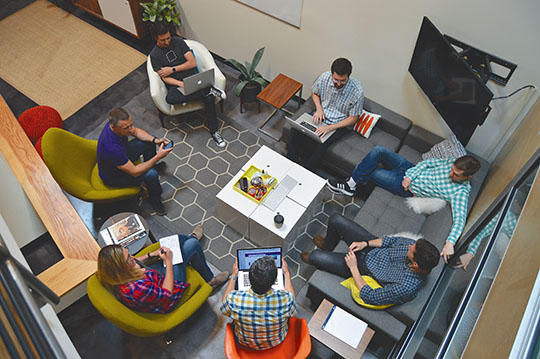
Employees at JLOOP, a digital creative agency located in the East Village Arts District, consult with one another in the firm’s collaborative meeting space. JLOOP boast’s an open floor plan that has become synonymous with creative agencies. (Photograph by the Business Journal’s Larry Duncan)
Tucked away in downtown creative suites, in industrial buildings in the historic Zaferia area and even in office buildings in East Long Beach’s traffic circle, these firms are informed by cultural shifts in what’s valued in the workplace and an evolving American consumer.
RMD Group, a marketing and branding agency in North Long Beach focused on experiential marketing – immersing consumers in a brand via real life experiences – is such a visual representation of what many have come to expect from the creative sector that major companies have used the space for promotional pieces. A day before the interview with the Business Journal, “Grace and Frankie,” the Netflix comedy starring Jane Fonda and Lily Tomlin, filmed at RMD to evoke that exact environment.
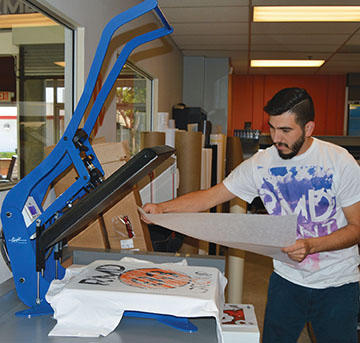
With specialized equipment, this RMD Group employee is able to print t-shirts for clients in a matter of minutes. (Photograph by the Business Journal’s Larry Duncan)
The 97,000-square-foot facility located next to a Food 4 Less on South Street is relatively unassuming from the exterior, but inside the sprawling space features floor to ceiling artwork, bright colors, games and collaborative open seating arrangements. There’s also a huge garage where the firm’s work on specialty autos takes place and is soon to get its own TV show.
“I think Google set the bar really high in having agency employees feel that they want to be there, they want to work there, they want to spend more time there and essentially get their best creativity out of it,” Ralph Holguin, owner and CEO of RMD Group, told the Business Journal in an interview at the firm’s offices. “How do we do that? By creating an environment that allows them not to be pigeonholed at a central desk . . . to really escape from your traditional cubicle. And that’s what we tried to do when we came here, to break away from the traditional office space.”
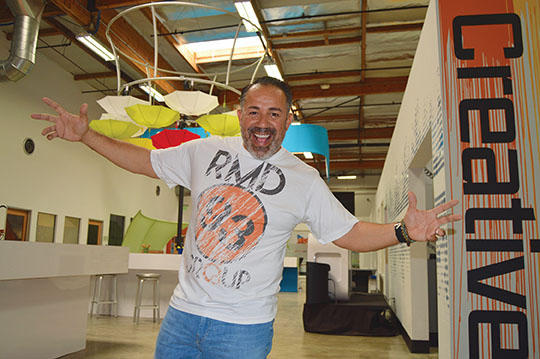
Ralph Holguin is CEO and owner of RMD Group, a creative agency in North Long Beach specializing in experiential marketing, among its other diverse services. The company’s 97,000-square-foot headquarters feature floor to ceiling art installations and artwork, massive equipment and open office space. (Photograph by the Business Journal’s Larry Duncan)
Holguin noted that fostering a creative work environment creates an internal work culture that’s appealing not only to employees but to clients. “Obviously, when our clients come here we want to transform the way they visualize not only their campaigns, but us,” he explained. “If we’re creative enough to create an environment we love, imagine what we do with their money. That’s really what’s been progressive for us.”
Jonathan Glasgow, principal of Zaferia District-based architecture firm Interstices, Inc., said the work he has done designing creative office space has common elements. “We used to do a lot of tenant improvements in Downtown Los Angeles where we just lined up cubicles. We did hundreds of cubicles for the Metropolitan Water District,” he recalled. “But now, a lot of those open office environments are more large spaces with kind of a peripheral working desk and computers and a big table in the middle where everybody collaborates.”
Glasgow added that, at creative offices, employees often do not have assigned desks but instead use whatever workspace is available. Desks where workers can stand at a computer are also trending in creative offices, he added. Part of the shift towards more flexible work environments has been driven by wireless technology, which allows workers more ability to roam rather than being stationed in one place, he explained.
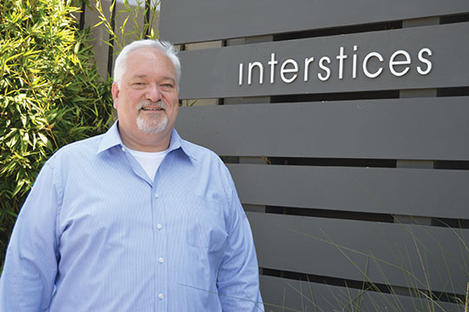
Jonathan Glasgow is principle of Zaferia District-based architecture firm Interstices. He has worked on many historic Long Beach properties, such as the Walker Building and the Kress Building in downtown. According to Glasgow, creative companies are seeking flexibility when it comes to designing their office space. (Photograph by the Business Journal’s Larry Duncan)
Joen Garnica, owner of Garnica Interiors, an interior design firm located on The Promenade in Downtown Long Beach, made similar observations about creative office space. “No one necessarily is looking for a private office anymore,” she said. “Many of them are moving toward being part of a bigger open space room, so it’s more collaborative, [with] less walls between people,” she explained. “We have that in our own office space. We do have cubicles, but it tends to be more of an open, collaborative flow.”
A trending shift in work culture from a “suit and tie” style to “a bit more laidback” attitude is also behind this shift, Garnica noted. “Even for creative offices, back in the day you’d have the suits, the ties, the panty hose. I mean, who wears panty hose now?” she said with a laugh. “We’ve certainly moved away from that where we’re a little bit more relaxed.”
Many creative sector and tech firms have been in the news in recent years for their emphasis on a more flexible work culture and work/life balance. Google’s career website, for example, boasts: “Take a vacation, volunteer, or flex your workday to meet your personal and business needs – there’s no one-size-fits-all recipe for helping you to be at your best.”
At JLOOP, a digital firm focused on building websites, apps and web-based software located in downtown’s East Village Arts District, team members take an occasional break from their daily workload to have some fun together or engage in healthy activities, President and Founder Jay Dysart told the Business Journal.
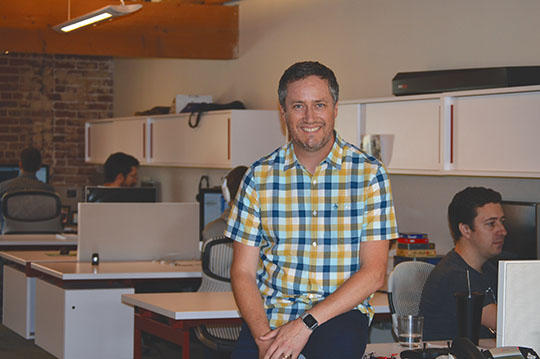
Jay Dysart, president and founder of JLOOP, said his company is made up of a tight-knit group of 10 people, plus an extended team that’s brought on for specific projects. JLOOP’s employees make time to integrate fun and exercise into their workdays on a regular basis. (Photograph by the Business Journal’s Larry Duncan)
“Whenever a month has a fifth Wednesday in it, we all go out as a team and do something fun,” Dysart said while lounging on a couch in the firm’s open office that’s part urban industrial, part Mad Men in its decor. “Sometimes it’s frivolous fun like lawn bowling, and sometimes it’s related to [our] industry and is something we want to explore or learn about together,” he explained.
Dysart is self-taught in his industry – he started off as a freelancer building Flash videos for websites. Prior to that, he worked in the theater industry and as a result has an appreciation for the importance of “getting up and moving your body,” he noted. “We have a yoga program that we do altogether on Wednesday mornings, trying to again look towards a long healthy life in technology. We all sit in front of our computers for the bulk of our day,” he said.
RMD Group is open-minded when it comes to work/life balance. “You have to remember that, outside of here, everybody has their personal lives,” Holguin said. “We’re flexible on opportunities, whether they have a doctors appointment or their spouse is coming in. Some people have brought their kids,” he said. “You’re going to get the most out of your team members when you also allow [flexibility] and you integrate yourself into what their lifestyles are.”
Creative Agencies And The Evolving American Consumer
Shifts in the habits and desires of the American consumer – driven largely in part by the Millennial generation coming of age – are transforming the way creative firms do business, which in some cases is launching them into success.
This is particularly true for SET Creative, a Portland-based experiential marketing firm that started up in 2009 and has since expanded with offices in New York, London and Amsterdam. In 2014, the firm opened a Downtown Long Beach office. Among the company’s clients are Google, Nike, Sprite, Jordan, BMW and others, according to Marketing Director Hyesun Ahn.
Being one of the earliest firms to specialize in experiential marketing helped the company grow quickly, Ahn said. “We really do consider ourselves the pioneers of brand experience,” she said, adding that the firm did not have overnight success. “In the last several years, brands have realized they can’t rely on traditional media or advertising any more to reach Millennials,” Ahn explained. “So they are understanding that brand experience is really the next biggest thing for marketers.”
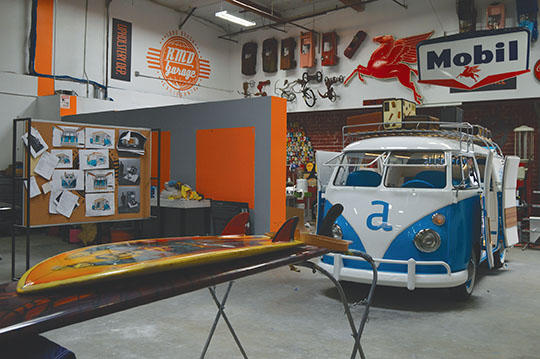
RMD Group’s garage is soon to be featured on a show on Velocity Network, where the its work on innovative vehicles for marketing and branding purposes will be showcased. This recently completed bus is soon to be installed in a creative firm in Irvine. Its interior features lounge seating, and the back of the bus has a keg hook up for happy hour. (Photograph by the Business Journal’s Larry Duncan)
Studies have shown that Millennials are craving experiences when they consider purchasing a product – a desire that’s drastically different than previous generations of consumers, according to Ahn. “It’s no longer just about a customer walking into a store and picking up a piece of merchandise and buying it,” she said. “We think of ways to help clients interact with the customer or anybody who walks into their store,” she explained.
SET Creative recently partnered with Jordan, Michael Jordan’s sports attire brand, to launch its flagship Chicago store. The store isn’t just about shopping – it’s about the experiences the brand has to offer. “If you go into that store, there’s a place where you can train athletes. There’s a place where you can shoot hoops, like a basketball court in the actual store. And then on top of that, we really encourage shoppers to try on new shoes,” Ahn said.
“Experiential marketing is literally transforming the way money’s spent, because your ad dollars are being used more on a grassroots level,” Holguin said. As experiential marketing is on the rise, so is the integration of social media in marketing, which might include sharing photos or videos on the mobile applications Instagram or Snapchat in order to convey a brand’s story, he added.
The popularity of mobile devices – a trend that began with Millennials and spread to many age groups – is also changing the way marketing agencies do business, according to Deborah Castro, president and CEO of Long Beach-based Creative Productions. “People are spending more time on their mobile devices. They are spending more time doing searches on their mobile device than they are on their desktop,” she said.
“You really need to design things that will work no matter what type of device you’re looking at,” she said. When it comes to advertising, “As much as story telling is important, it’s also important to serve up things in small bites because of the fact that it is on a mobile device,” she explained. “It’s kind of the whole emoji generation, where you have to tell it with less words in a lot of cases.”
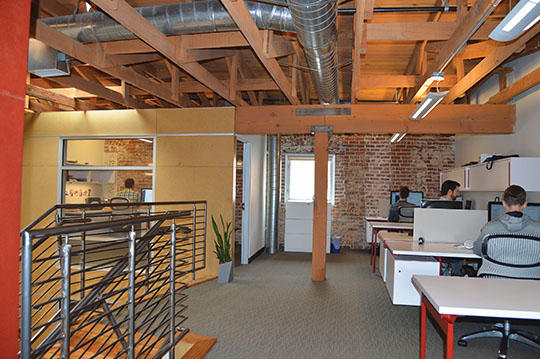
Employees work in an open office environment at JLOOP, a Downtown Long Beach-based creative agency specializing in digital platforms. (Photograph by the Business Journal’s Larry Duncan)
Because many of today’s consumer trends are driven by Millennials, Holguin said he’s tapping into that generation’s knowledge. “Everybody wants to target Millennials. And who knows them better than themselves?” he said. “So the thing for us has been integrating Millennials here, bringing them into our work force and then empowering them.” Older employees with more experience bring the “how-tos” to the table, while Millennials let the firm know what’s trending, he explained.
Moving forward, many of those interviewed by the Business Journal expressed their intent to increasingly work with other local creative firms in the future, not just in business but also to promote their presence in the community.
“There are so many creative spaces in Long Beach, and we need to just bring them out so that the huge [creative] agencies and the startups find Long Beach to be their next home,” Holguin said.
“There’s a very cool environment happening, and I see that around town as people are connecting more,” Dysart said. “I’m strongly thinking about trying to advocate for some more creative collaboration in the community,” he continued. “We’ve reached critical mass of good work and good people. And I think there’s an opportunity there.”
